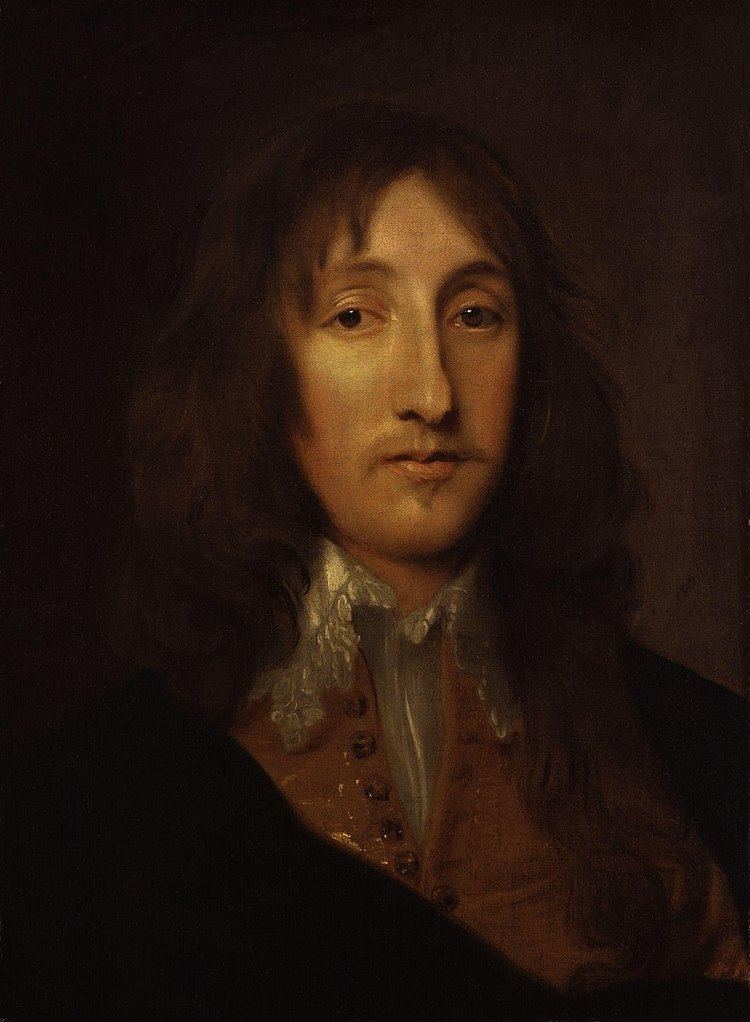Died January 15, 1698 Name Richard 1st | Nationality British Tenure 1664–1698 | |
 | ||
Spouse Elizabeth Clifford, 2nd Baroness Clifford (m. 1635) Children Charles Boyle, 3rd Viscount Dungarvan Great grandchildren Richard Boyle, 3rd Earl of Burlington | ||
Richard Boyle, 1st Earl of Burlington, 2nd Earl of Cork (20 October 1612 – 15 January 1698) was an Anglo-Irish nobleman who served as Lord High Treasurer of Ireland and was a Cavalier.
Contents

Early life
He was born in The College in Youghal in the south-east of County Cork, Ireland, the sixth child and second son of Richard Boyle, 1st Earl of Cork, and his second wife, Catherine, daughter of Sir Geoffrey Fenton. On 13 August 1624, The Hon. Richard Boyle, Jr., was knighted at his father's house in Youghal, by Lord Falkland, the Lord Deputy of Ireland. As The Hon. Sir Richard Boyle, he then went on travels abroad with an annual allowance of £1500.
Civil War
In 1639, the young Sir Richard undertook to raise, arm, and provide 100 horse to attend upon King Charles I of England in his expedition into the North of England against the Scots. For this and other occasions, his father, Lord Cork, supplied him with £5553 sterling. Sir Richard Boyle was returned as Member of Parliament for Appleby in the Long Parliament of 1640, and appointed a member of the Privy Council of England, but was subsequently excluded for his Royalist sympathies after the outbreak of the English Civil War.
He and Lord Inchiquin commanded the forces which defeated the Irish irregular army at the Battle of Liscarroll on 3 September 1642, thereby preserving the Protestant interest in southern Ireland for the remainder of the decade. A cessation of hostilities was concluded with the Irish a year later (15 September 1643). He then applied to the King, in December, for consent to bring his regiment to serve him in England, and landed his men near Chester the following February. He then marched to the King's aid in Dorset, supplying this monarch with large sums of money for his cause.
He fought throughout the Civil War until the final defeat of the Royalist forces. The Commonwealth fined him £1631 sterling and he then went abroad, returning to Ireland at the request of the government, dated 2 January 1651.
Peerages and appointments
Upon the death of his brother Lord Boyle of Kinalmeaky on 2 September 1642, Sir Richard Boyle succeeded as 2nd Viscount Boyle of Kinalmeaky. King Charles I thereafter created him Baron Clifford of Lanesborough, in the County of York, on 4 November 1644. He succeeded as The 2nd Earl of Cork upon the death of his father on 15 September 1643.
Following the Restoration, Lord Cork was appointed a Privy Counsellor and Lord Treasurer of Ireland on 16 November 1660. On 22 February 1660 he was made Custos Rotulorum of County Cork and of Waterford, and, on 19 March 1660, was appointed one of the Commissioners for the settlement of Ireland following the King's declaration to that effect of 30 November 1659. On 25 June 1661, he took his seat above all the peers, as Lord Treasurer, in the Irish House of Lords in the Irish Parliament.
He had a reversionary grant date 5 July 1661, of the command of a troop of horse, and on 24 March 1662, he was made governor of the fort of Harbouling on the river Cork (River Lee?), at six shillings a day.
King Charles II created him Earl of Burlington on 20 March 1664, and on 13 March 1666, he was appointed Lord Lieutenant of Yorkshire.
Lord Burlington (as he was usually known for short from 1664 onwards), along with several other noblemen and Bishops of the Church of Ireland, were opposed to the attempts of King James II regarding the restoration of Roman Catholicism and petitioned the King on 17 November 1688 to call a parliament "regular and free in all its circumstances". This petition had a hostile reception from James. Following the arrival of William of Orange in England, King James removed to Ireland where he called a parliament in 1689, which passed a general act of attainder against the Protestants, and confiscated their estates, among whom was the Earl of Burlington (who was also Earl of Cork). This was overturned by King William the following year.
On 3 March 1691, he was appointed one of the newly incorporated Society of the Royal Fishery in Ireland.
Family and death
At the age of 22 he married the 21-year-old Lady Elizabeth Clifford, daughter of Henry Clifford, 5th Earl of Cumberland, on 5 July 1635 in Skipton Castle. They had six children:
Lord Burlington died on 6 January 1698 and was buried on 3 February 1698 at Londesborough in Yorkshire. He was succeeded by his grandson, Charles Boyle, 2nd Earl of Burlington.
